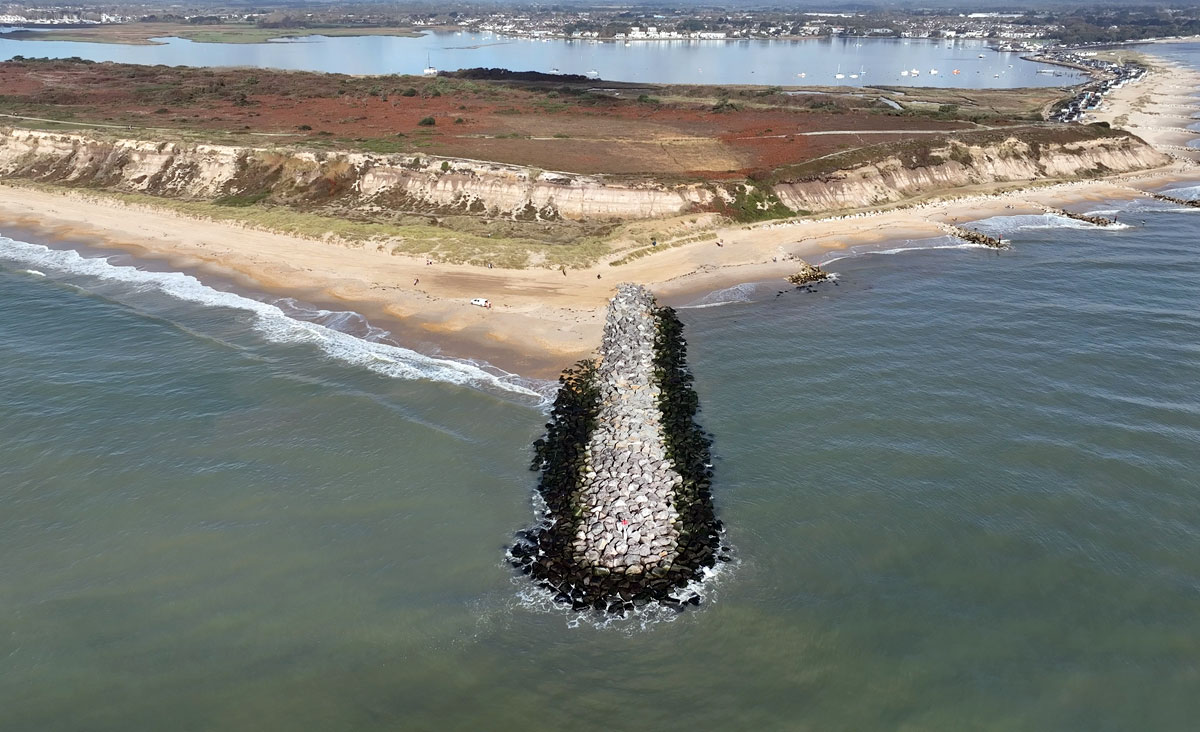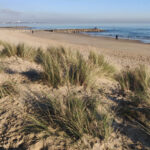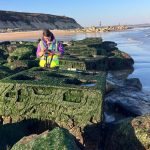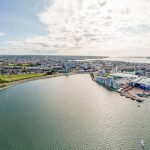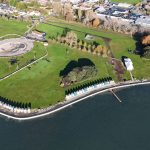The upgrade of Hengistbury Head Long Groyne is now complete, protecting up to 6,000 homes within the Poole and Christchurch Bays area.
The works, which began in April 2024, enable the groyne to continue to reduce the risk of coastal erosion over the next 100 years. The beach around Hengistbury Head Long Groyne is now fully open to the public again.
The Long Groyne remains at its original length of approximately 150 metres from the beach line but is 1.5m higher and almost double the width – 30m at its widest point. This makes it more resilient to projected sea level rise and the increasing number of storm events predicted over the next century.
During construction, the original 1939 structure was dismantled, with the salvaged material re-used to form the core of the upgraded Long Groyne. Nearly 30,000 tonnes of new, highly durable rock was delivered by sea and transported along the beach to site. Each granite rock weighed between 6-10 tonnes and was carefully placed using one of three 110 tonne long-reach excavators.
The works have also seen important benefits for the natural environment. New and improved habitats have been provided around the Hengistbury Head nature reserve; including for the UK’s rarest amphibian, the Natterjack Toad. New marine habitats have also been incorporated to attract and increase the number of species living on or under the water around the Long Groyne.
Councillor Andy Hadley, Portfolio for Climate Response, Environment and Energy, said:
“We are delighted that the upgrade of the Long Groyne, which plays a significant role in reducing the risks of coastal erosion from the Purbecks to Hurst Spit, has finished ahead of time and within budget.
“I’d like to thank everyone involved in the scheme who has worked so hard to ensure our coastline remains resilient to predicted sea level rise over the next 100 years, while the introduction of enhancements to boost biodiversity is welcomed and will allow marine and wildlife to continue to flourish in the area.
“I’d also like to thank the public for their vigilance and patience during construction. Now that our works have left the beach and safety checks have been made, the beach will return to its natural beauty.”
Following completion of the Long Groyne works, and while machinery remains available, approximately 8,000 tonnes of the rock delivered to site is being used to adapt and upgrade a further two short groynes near Solent Beach car park. This involves removing 10 old wooden piles from the outer, seaward end of each groyne and replacing them with the same durable rock used on the Long Groyne.
This will ensure they continue to perform their coastal protection role effectively into the future, including protecting the seaward end of the historic Iron Age Double Dykes embankment. It is anticipated these works will finish by end of November 2024 (subject to weather and tides).
Notes to Editors
- The combined cost of the works for the Long Groyne and two short groynes is £10 million. It is part of the £36.6 million Poole Bay Beach Management Scheme (Phase 2 & 3). In May 2020 the Environment Agency awarded BCP Council £33 million of combined government Flood Defence Grant in Aid (FDGiA) and Local Levy. A capital contribution of £3.3 million by BCP Council was approved in October 2019.
- Photos of the construction and marine enhancements can be found on the Hengistbury Head Long Groyne project webpage
- From 08 November, special matting will be laid on the grass between Double Dykes and the Hengistbury Head car park. During week commencing 11 November, the three 110 tonne excavators will be moved from the beach, across the grass to the car park where they will be dismantled. A police escort will accompany the giant excavators when they leave the car park. This is planned to take place over three separate days towards the end of the week.
- The Long Groyne works were licensed to take place from 01 April to 31 October 2024 and were delivered by contractors VBA Joint Venture Ltd. (VBA – VolkerStevin, Boskalis Westminster and AtkinsRéalis). Boskalis was the contractor on site.
- Construction was permitted to take place over the summer months because Hengistbury Head has special status as a protected area, particularly for providing shelter to overwintering birds. It is of natural and cultural importance and is a Site of Special Scientific Interest (SSSI) and a Scheduled Monument, meaning it is a protected archaeological site and designated to be of international significance.

